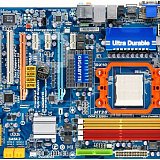Gigabyte GA-MA790GP-UD3H: инструкция
Инструкция к Материнской Плате Gigabyte GA-MA790GP-UD3H
GA-MA790GP-UD3H
AM2+/AM2 socket motherboard for
TM
TM
AMD Phenom
II X4 processor/AMD Phenom
II X3 processor/
TM
TM
AMD Phenom
FX processor/AMD Phenom
X4 processor/
TM
TM
AMD Phenom
X3 processor/AMD Athlon
X2 processor/
TM
TM
AMD Athlon
processor/AMD Sempron
X2 processor/
TM
AMD Sempron
processor
User's Manual
Rev. 1001
12ME-MA79PU3-1001R

GA-MA790GP-UD3H
May 7, 2009
Motherboard
May 7, 2009
GA-MA790GP-UD3H
Motherboard

Copyright
© 2009 GIGA-BYTE TECHNOLOGY CO., LTD. All rights reserved.
The trademarks mentioned in this manual are legally registered to their respective owners.
Disclaimer
Information in this manual is protected by copyright laws and is the property of GIGABYTE.
Changes to the specifications and features in this manual may be made by GIGABYTE without prior
notice. No part of this manual may be reproduced, copied, translated, transmitted, or published in any
form or by any means without GIGABYTE's prior written permission.
Documentation Classifications
In order to assist in the use of this product, GIGABYTE provides the following types of documentations:
For quick set-up of the product, read the Quick Installation Guide included with the product.
For detailed product information, carefully read the User's Manual.
For instructions on how to use GIGABYTE's unique features, read or download the information
on/from the Support&Downloads\Motherboard\Technology Guide page on our website.
For product-related information, check on our website at:
http://www.gigabyte.com.tw
Identifying Your Motherboard Revision
The revision number on your motherboard looks like this: "REV: X.X." For example, "REV: 1.0"
means the revision of the motherboard is 1.0. Check your motherboard revision before updating
motherboard BIOS, drivers, or when looking for technical information.
Example:

Table of Contents
Box Contents ................................................................................................................. 6
Optional Items ................................................................................................................. 6
GA-MA790GP-UD3H Motherboard Layout .................................................................... 7
Block Diagram................................................................................................................ 8
Chapter 1 Hardware Installation .................................................................................... 9
1-1 Installation Precautions ..................................................................................... 9
1-2 Product Specifications .................................................................................... 10
1-3 Installing the CPU and CPU Cooler.............................................................. 13
1-3-1 Installing the CPU ................................................................................................ 13
1-3-2 Installing the CPU Cooler ................................................................................... 15
1-4 Installing the Memory ..................................................................................... 16
1-4-1 Dual Channel Memory Configuration................................................................ 16
1-4-2 Installing a Memory............................................................................................. 17
1-5 Installing an Expansion Card ......................................................................... 18
TM
1-6 Enabling the ATI Hybrid CrossFireX
Function ............................................ 19
TM
1-7 Setup of ATI CrossFireX
Configuration ........................................................ 20
1-8 Back Panel Connectors ................................................................................. 21
1-9 Internal Connectors ........................................................................................ 24
Chapter 2 BIOS Setup................................................................................................. 35
2-1 Startup Screen ................................................................................................ 36
2-2 The Main Menu .............................................................................................. 37
2-3 MB Intelligent Tweaker(M.I.T.) ....................................................................... 39
2-4 Standard CMOS Features ............................................................................. 44
2-5 Advanced BIOS Features.............................................................................. 46
2-6 Integrated Peripherals ..................................................................................... 49
2-7 Power Management Setup ............................................................................. 52
2-8 PnP/PCI Configurations................................................................................. 54
2-9 PC Health Status ........................................................................................... 55
2-10 Load Fail-Safe Defaults................................................................................... 57
2-11 Load Optimized Defaults ................................................................................. 57
2-12 Set Supervisor/User Password..................................................................... 58
- 4 -

2-13 Save & Exit Setup......................................................................................... 59
2-14 Exit Without Saving ....................................................................................... 59
Chapter 3 Drivers Installation ...................................................................................... 61
3-1 Installing Chipset Drivers ............................................................................... 61
3-2 Application Software ....................................................................................... 62
3-3 Technical Manuals.......................................................................................... 62
3-4 Contact........................................................................................................... 63
3-5 System........................................................................................................... 63
3-6 Download Center ............................................................................................ 64
Chapter 4 Unique Features......................................................................................... 65
4-1 Xpress Recovery2 ......................................................................................... 65
4-2 BIOS Update Utilities..................................................................................... 68
4-2-1 Updating the BIOS with the Q-Flash Utility...................................................... 68
4-2-2 Updating the BIOS with the @BIOS Utility ....................................................... 71
4-3 EasyTune 6 .................................................................................................... 72
4-4 Easy Energy Saver ...................................................................................... 73
Chapter 5 Appendix .................................................................................................... 75
5-1 Configuring SATA Hard Drive(s) .................................................................... 75
5-1-1 Configuring the Onboard SATA Controller......................................................... 75
5-1-2 Making a SATA RAID/AHCI Driver Diskette for Windows XP........................ 81
5-1-3 Installing the SATA RAID/AHCI Driver and Operating System ...................... 82
5-2 Configuring Audio Input and Output ................................................................. 86
5-2-1 Configuring 2/4/5.1/7.1-Channel Audio ............................................................ 86
5-2-2 Configuring S/PDIF In/Out .................................................................................. 88
5-2-3 Configuring Microphone Recording ................................................................... 90
5-2-4 Using the Sound Recorder................................................................................. 92
5-3 Troubleshooting ............................................................................................... 93
5-3-1 Frequently Asked Questions ............................................................................. 93
5-2-2 Troubleshooting Procedure ................................................................................ 94
5-4 Regulatory Statements ................................................................................... 96
- 5 -

Box Contents
GA-MA790GP-UD3H motherboard
Motherboard driver disk
User's Manual
Quick Installation Guide
One IDE cable
Two SATA 3Gb/s cables
I/O Shield
• The box contents above are for reference only and the actual items shall depend on product package you obtain.
The box contents are subject to change without notice.
• The motherboard image is for reference only.
Optional Items
Floppy disk drive cable (Part No. 12CF1-1FD001-7*R)
2-port USB 2.0 bracket (Part No. 12CR1-1UB030-5*R)
2-port IEEE 1394a bracket (Part No. 12CF1-1IE008-0*R)
2-port SATA power cable (Part No. 12CF1-2SERPW-0*R)
COM port cable (Part No. 12CF1-1CM001-3*R)
S/PDIF in and out cable (Part No. 12CR1-1SPINO-1*R)
- 6 -







